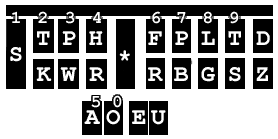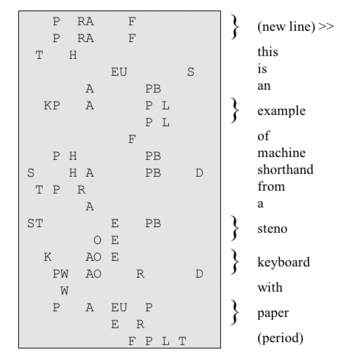
A stenotype, stenotype machine or shorthand machine is a specialized chorded keyboard or typewriter used by stenographers for shorthand use. In order to pass the Registered Professional Reporter test, a trained court reporter or closed captioner must write speeds of approximately 180, 200, and 225 words per minute at very high accuracy in the categories of literary, jury charge, and testimony, respectively.[1] Many users of this machine can even reach 300 words per minute and per the website of the California Official Court Reporters Association the official record for American English is 375 wpm.

The stenotype keyboard looks more like a piano than a conventional alphanumeric keyboard. Multiple keys are pressed simultaneously (known as "chording" or "stroking") to spell out whole syllables, words, and phrases with a single hand motion. This system makes realtime transcription practical for court reporting and live closed captioning. Because the keyboard does not contain all the letters of the English alphabet, letter combinations are substituted for the missing letters. There are several schools of thought on how to record various sounds, known as "theories", such as the StenEd, Phoenix, and Magnum Steno theories.
The first shorthand machine (the word "stenotype" was not used for another 80 years or more) punched a paper strip and was built in 1830 by Karl Drais. An American shorthand machine was patented in 1879 by Miles M. Bartholomew. A French version was created by Marc Grandjean in 1909. The direct ancestor of today's stenotype was created by Ward Stone Ireland in about 1913 or so, and the word "stenotype" was applied to his machine and its descendants sometime thereafter.
Most modern stenotype keyboards have more in common with computers than they do with typewriters or QWERTY computer keyboards. Most contain microprocessors, and many allow sensitivity adjustments for each individual key. They translate stenotype to English internally using user-specific dictionaries, and most have LCD screens. They typically store a full day's work in non-volatile memory of some type, such as a floppy disk, hard drive, or non-volatile RAM. These factors influence the price, along with economies of scale, as there are only a few thousand stenotype keyboards sold each year. As of April 2008, student models such as a Stentura 400SRT sell for about US $1,500 and top-end models sell for approximately US$ 5,000. Machines that are 30–40 years old still resell for upwards of $350.
In "home position," the fingers of the left hand rest along the gap between the two main rows of keys to the left of the asterisk (little finger on the "S" to forefinger on the "H" and "R"). These fingers are used to generate initial consonants. The fingers of the right hand lie in the corresponding position to the right of the asterisk (forefinger on "FR" to little finger on "TS"), and are used for final consonants. The thumbs produce the vowels.

The system is roughly phonetic, for example the word "cat" would be written by a single stroke comprising the initial K, the vowel A, and the final T.
To enter a number, a user presses the number bar at the top of the keyboard at the same time as the other keys, much like the shift key on a QWERTY based keyboard. The illustration shows which lettered keys correspond to which digits. Numbers can be chorded just as letters can. They read from left to right across the keyboard. It's possible to write 137 in one stroke by pressing the number bar along with SP-P, but it takes three separate strokes to write 731. Many court reporters and stenocaptioners write out numbers phonetically instead of using the number bar.
There are various ways to combine letters to make different sounds; different court reporters use different theories in their work. Although historically reporters often created "briefs" (abbreviations) on-the-fly and sometimes mixed theories, which could make it difficult for one reporter to read another reporter's notes, current versions of theories are primarily designed for computerized translation using a standardized dictionary provided by the company that promulgates the theory, which forces reporters to stick with one theory and use only the specific combinations in that company's dictionary. However it is not uncommon for students and reporters to add a significant number of entries to a stock dictionary (usually when creating briefs of their own).
Some court reporters use scopists to translate and edit their work. A scopist is a person who is trained in the phonetic language, English punctuation, and usually in legal formatting. They are especially helpful when a court reporter is working so much that they do not have time to edit their own work. Both scopists and proofreaders work closely with the court reporter to ensure an accurate transcript. However, the widespread use of automatic computerized translation of the strokes has reduced the demand for scopists. With transcripts produced on computer-aided transcription (CAT) software, a scopist no longer needs to have any knowledge of shorthand theories because the software converts shorthand to English in realtime, via a dictionary. However, it may still be helpful in some situations while scoping. Depending on availability of scopists and proofreaders, a court reporter may only use a scopist to clean up a rough draft of their transcript, then proofread and certify the transcript themselves; or they may not use either and produce a final transcript by themselves, though this is a very time-consuming practice.
Steno paper
Steno paper comes out of a stenotype machine at the rate of one row per chord, with the pressed letters printed out in 22 columns corresponding to the 22 keys, in the following order: S T K P W H R A O * E U F R P B L G T S D Z

home
409you can request any kind of educational research or email to us your educational research mechanical_bulate15@yahoo.com thx to all stravinsky.xtgem.com
1